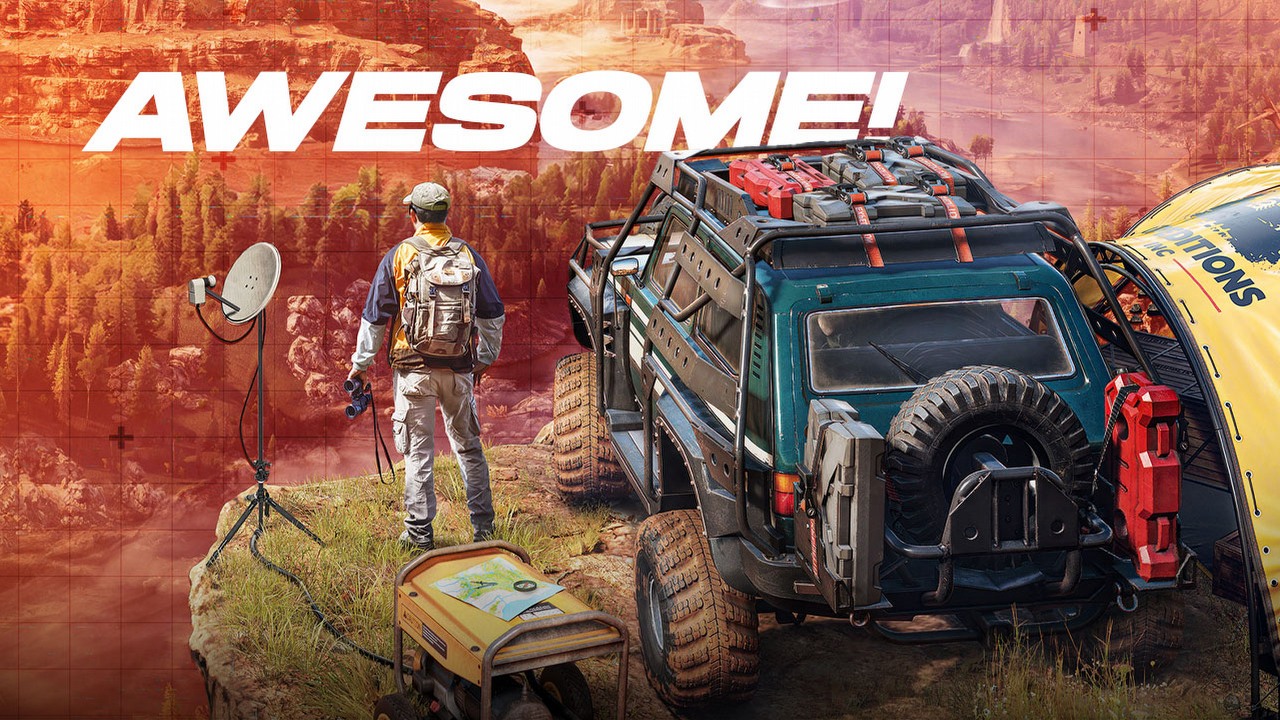Snowrunner Was Sensational; Expeditions Will Be Even Better!
The MudRunner series has been providing predictable but nonetheless wildly (and weirdly) addictive off-road driving fun for years now. Expeditions builds on the ideas of previous installments in the series and focuses on exploration, which it frankly does surprisingly well.

I've been playing MudRunner since the very beginning, from the days of the "grandfather" of this series, Spintires. The first part of the series appeared groundbreaking to me, even though I realize it may sound amusing when referring to driving trucks through mud and rough terrain. However, it needs to be clearly stated that there simply wasn't anything like this available on the market. The advanced terrain deformation simulation, impressive driving physics, and a focus on transportation gameplay rather than racing all represent a breath of fresh air. I developed a fondness for Spintires and appreciated the more refined MudRunner and the alluring SnowRunner. I wasn't sure what to expect after the announcement of Expeditions, as it seemed like more of the same for the fourth time. Recently, however, I had the chance to try out an early version of the game (for about 6 hours) and I can say that I really enjoyed it. The developers not only avoided making a salad out of old lettuce, but they also added something fresh and new to it - in other words, great fun is expected.
Drones, sonars, and anchors come in handy
Expeditions: A MudRunner Game makes it clear right from the start: "Hey, I'm not like the others!" This becomes apparent when the tutorial mission starts, during which the developers adeptly introduce all the new mechanics and immerse players in the world of their most recent game, with a greater focus on research and exploration.
Let's begin with these last two elements, as they form the core of the "plot" of Expeditions. Our responsibilities in previous titles were quite practical - delivering wood, fuel, spare parts, and so on. Expeditions places us in the position of explores, discovering uncharted territories, and seeking treasures. This is a pretty good update of the classic formula, thanks to various findings, discoveries, and similar activities that encourage further play. It seems like we are traveling through the wilderness, transporting cargo, yet there's a sense that it's something unique, fresh.
The test version of Expeditions includes a total of 88 missions across 3 distinct biomes: Little Colorado (with 6 tutorial expeditions), Arizona, and the Carpathians.
The thing that immediately caught my eye were the new vehicle features that we can use during off-road tours. We used to select the type of tires based on the region we were planning to travel through, but now we can also adjust their air pressure. Maximum pressure allows for faster driving and lower fuel consumption while reducing it improves traction at the expense of higher fuel consumption. It has proven to be very useful during the game, as I have managed to escape from some really tough situations using this method. Furthermore, each additional modifier increases the reliance on us and decreases the reliance on chance. Big kudos.
Many people were likely waiting for the introduction of the anchors, which finally allowed the winch to be used regardless of the surroundings. We no longer need to rely on the presence of a small tree or some other anchor point near the place where we are stuck. We just need to place the anchor on solid ground and we can dig ourselves out of even the thickest mud. It's important to keep in mind that each anchor comes with a cost, so when going on an expedition, it's advisable to calculate how many of them are worth purchasing in order to make any profit from the trip at all.
Drones are an interesting addition that strongly highlights the developers' emphasis on exploration. During the game, we can release this device into the air to explore a specific area, map out the best route, and search for equipment containers. The containers are a kind of reward for exploring in Expeditions and enables, for instance, the refilling of fuel or spare parts. Echo sounders are another technological accessory that measure the depth of water reservoirs, allowing us to determine whether we can pass through them safely or if we risk damaging or submerging the vehicle.
Tuning and crews await
If you haven't had enough novelties yet, I have more for you, this time with a slightly less direct impact on the fun. In Expeditions, you'll have the opportunity to employ team members who will assist you on future expeditions. However, they won't help you "live," but rather through special modifiers, such as -30% fuel consumption or +15% damage resistance. Hiring any of them comes with extra expenses, but it can be worthwhile as they often help you reach your goal more quickly and efficiently. The garage staff in Expeditions can be quite large, as it allows you to employ mechanics, logisticians, hydrologists, field scouts, operators, and managers.
I also really liked the tuning option, which allows for modifying the car and changing its aesthetics. Engine parts, suspension, tires, or even the winch can be upgraded. Furthermore, you have the choice to buy extra features like special roofs, bumpers, or rims, and the option to customize the car with paint or stickers. In a nutshell - the full package.
Nice graphics and optimization arrived
Although I tested an early version of Expeditions: A MudRunner Game, I'd like to also discuss the visual design and performance optimization. The game's performance often falls short before its release, and proper optimization typically occurs shortly before the title's debut. In the case of Expeditions, things are going very well, and I believe they can only improve from here. I tried out the game on a powerful computer with an RTX 4080, and it ran smoothly at over 120 fps on ultra settings, but that's not particularly unusual. I find it much more interesting that the game ran fluidly at 40 frames per second on the Steam Deck with medium graphic settings! I even attempted to raise them to high levels, and after capping the FPS at 30, I found the gameplay very comfortable, all without any resolution scalers like DLSS or FSR.
The visual design of Expeditions is also a progression from the previous installments in the series. The lighting, texture resolution, terrain coverage with details, and all other visual elements appear superior to those in SnowRunner, which is clearly visible to the naked eye without the need to search for small details pixel by pixel.
Step in the right direction
My early caution (not to say skepticism) about the new installment of MudRunner quickly turned into a very strong fondness, and frankly, after these few hours of gameplay, it's hard for me to find any major defects or warning signs. It seems like it's worth waiting for Expeditions: A MudRunner Game, and it will be a must-have for fans of the series, as well as others. I feel like this installment is more focused on attracting new players than the previous ones. This isn't about lowering the difficulty level or the quality of the simulations (which are still excellent and balanced), but rather improving fundamental elements such as a more console and gamepad-friendly interface, clearer menu panels, better explained options, and more precise tutorials. If I had to put my money today on whether Expeditions would be a hit or a miss, I'd bet on the former. I am looking forward to the full version.
4

Author: Mikolaj Laszkiewicz
Have been working at gamepressure.com since May 2020. First, he was a newsman in the Technology department, over time he began to get involved in games and journalism, as well as edit and supervise the Technology newsroom. He previously shared his thoughts on video games in, e.g. various thematic groups. A lawyer by education. He plays on everything and in everything, which can sometimes be reflected in his reviews. His favorite console is the Nintendo 3DS, he plays a new FIFA every year and tries to broaden his gaming horizons. Loves broadly understood computer equipment and disassembles everything that falls into his hands.
Latest News
- End of remote work and 60 hours a week. Demo of Naughty Dog's new game was born amid a crunch atmosphere
- She's the new Lara Croft, but she still lives in fear. Trauma after Perfect Dark changed the actress' approach to the industry
- „A lot has become lost in translation.” Swen Vincke suggests that the scandal surrounding Divinity is a big misunderstanding
- Stuck in development limbo for years, ARK 2 is now planned for 2028
- Few people know about it, but it's an RPG mixing Dark Souls and NieR that has received excellent reviews on Steam, and its first DLC will be released soon


